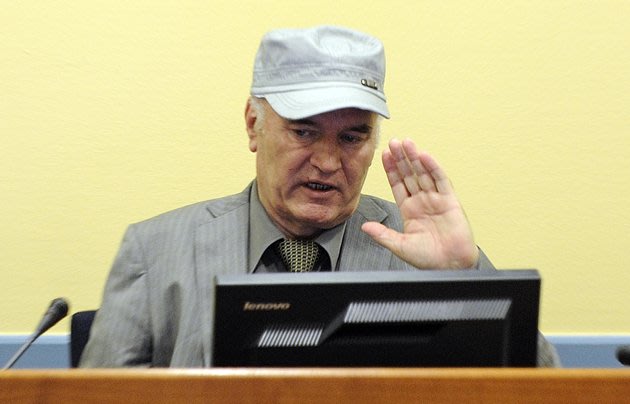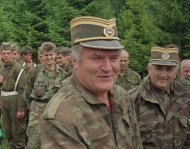THE HAGUE, Netherlands (AP) — He's no longer the swaggering general who held Sarajevo "in the palm of his hand" during Bosnia's 1992-95 war. Yet as his long-awaited genocide trial began Wednesday, Ratko Mladic still managed to reopen old wounds with the flick of his hand.
Hobbled by strokes and wearing a business suit instead of combat fatigues, the frail, 70-year-old defendant had an angry exchange of hand gestures with the families of massacre victims in the public gallery, separated by the bulletproof glass in the courtroom.
"Vulture!" said one woman in the gallery.
Watching the war crimes trial on television in Bosnia, Mevlija Malic added: "Not even an animal would behave like that."
Mladic is accused of commanding Bosnian Serb troops who waged a campaign of murder and persecution to drive Muslims and Croats out of territory they considered part of Serbia. His troops rained shells and snipers' bullets down on civilians in the 44-month-long siege of the Bosnian capital, Sarajevo, and killed 8,000 Muslim men and boys in Srebrenica in July 1995, Europe's worst massacre since World War II.
"The world watched in disbelief that in neighborhoods and villages within Europe a genocide appeared to be in progress," prosecutor Dermot Groome said at the U.N. court in The Hague.
Twenty years after the war that left 100,000 dead, Bosnia remains divided into two ministates — one for Serbs, the other shared by Bosnian Muslims and Croats — linked by a central government.
Mladic fled into hiding after the war and spent 15 years as a fugitive before international pressure on Serbia led to his arrest last year. Now he is held in a one-man cell in a special international wing of a Dutch jail and receives food and medical care that would likely be the envy of many in Bosnia.
But the fact that he is jailed and on trial is seen as another victory for international justice and hailed by observers as evidence that — more often than not — war crimes tribunals get their indicted suspects, even if years later. In another court Wednesday in The Hague, former Liberian President Charles Taylor faced a sentencing hearing after being convicted last month of aiding rebels in neighboring Sierra Leone's civil war.
That is heartening news for the International Criminal Court, which has indicted the likes of Sudanese President Omar al-Bashir for genocide but appears nowhere close to having him arrested.
In a demonstration of Bosnia's continuing ethnic divide, Mladic's entrance in court was applauded by people who gathered in the Serb stronghold of Pale to watch the trial on TV.
"Mladic is our hero. It's sad that we see him there," said Milan Ivanovic, a 20-year-old law student.
Groome told the three-judge panel that Mladic was hand-picked by Bosnian Serb leader Radovan Karadzic because of his skills as a military commander, but also "because Karadzic believed he was willing to commit the crimes needed to achieve the strategic goals of the Bosnian Serb leadership."
He signaled that prosecutors would use Mladic's own words against him in the trial, drawing on the former general's wartime diaries, radio intercepts and appearances on television during the war.
In one such TV appearance, Mladic showed a news team around the Serb artillery dug into hills overlooking Sarajevo and denied any involvement in war crimes — foreshadowing his defense now that his actions were intended only to protect Serbs.
"I did not take part in any crimes. I have only defended my people," Mladic said. He denies wrongdoing but has refused to enter pleas to the 11 charges against him in The Hague.
In another video, however, he is heard boasting: "Whenever I come by Sarajevo, I kill someone in passing. ... I go kick the hell out of the Turks" — a denigrating reference to Bosnian Muslims.
Groome said Mladic "held Sarajevo in the palm of his hand," playing an intercepted radio communication of the former commander ordering the shelling of part of the city and a video of civilians scurrying across devastated streets to avoid sniper fire.
The attacks were part of an "overarching" plan by Karadzic and former Yugoslav President Slobodan Milosevic to drive non-Serbs from large parts of Bosnia and to carve out a "Greater Serbia" from the ruins of the former Yugoslavia, Groome said.
Karadzic is also on trial at the tribunal following his 2008 arrest. Milosevic was put on trial here, too, for fomenting wars across the Balkans, but he died of a heart attack in 2006 before judges could deliver their verdict.
Prosecutors say they will use evidence against Mladic from more than 400 witnesses, although very few of them will testify in court. Much of their evidence already has been heard in other cases and will be admitted as written statements.
The first witness is to start testifying May 29, but Presiding Judge Alphons Orie of the Netherlands hinted that he may postpone the case because prosecutors have not disclosed all the evidence to Mladic's defense.
Bosnia's president hailed the trial's opening as a historic day in the still-bitterly divided country's recovery from its war wounds.
"First of all, we are expecting from this trial the truth," said Bakir Izetbegovic. "The truth and then justice for the victims, for the families of the victims. It is the worst period of our history."
Mladic gave a thumbs-up and clapped toward the gallery as the trial got under way. He occasionally wrote notes and showed no emotion as prosecutors outlined his alleged crimes.
After the brief exchange between Mladic and the gallery, Orie rebuked both about "inappropriate interactions" and said he might shield the defendant behind a screen if the outbursts continued.
Munira Subasic, who lost 22 relatives in the Srebrenica massacre, claimed Mladic made a throat-slitting gesture toward her after she had held up both her hands, wrists crossed to indicate Mladic was in captivity. Mladic's lawyer, Branko Lukic, did not confirm her version of events, but claimed that somebody in the audience raised their middle finger at Mladic.
"He is very easily provoked and we had that gallery full of people very ready to provoke," Lukic said.
In Srebrenica, widows and mothers of the massacre victims gathered to watch the trial together and were outraged at Mladic's apparent lack of emotion.
Suhreta Malic, who had more than 30 relatives killed in the massacre, cried as she sat in front of the TV with photos of her dead children in her hands.
"This is so painful for us. It really hurts," she said. "We did not lose some chicken. We lost our sons."
___
Sabina Niksic in Srebrenica and Aida Cerkez and Amer Cohadzic in Sarajevo contributed to this report.

 View Photo
View Photo View Gallery
View Gallery